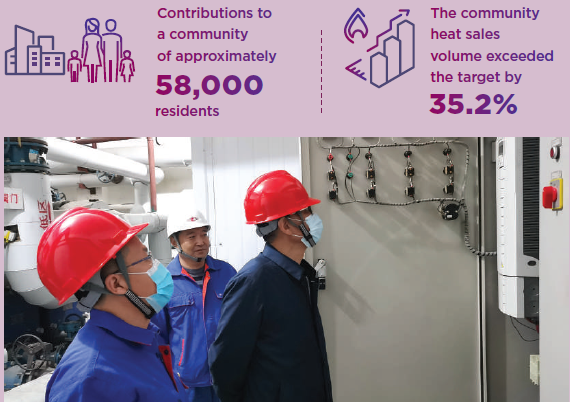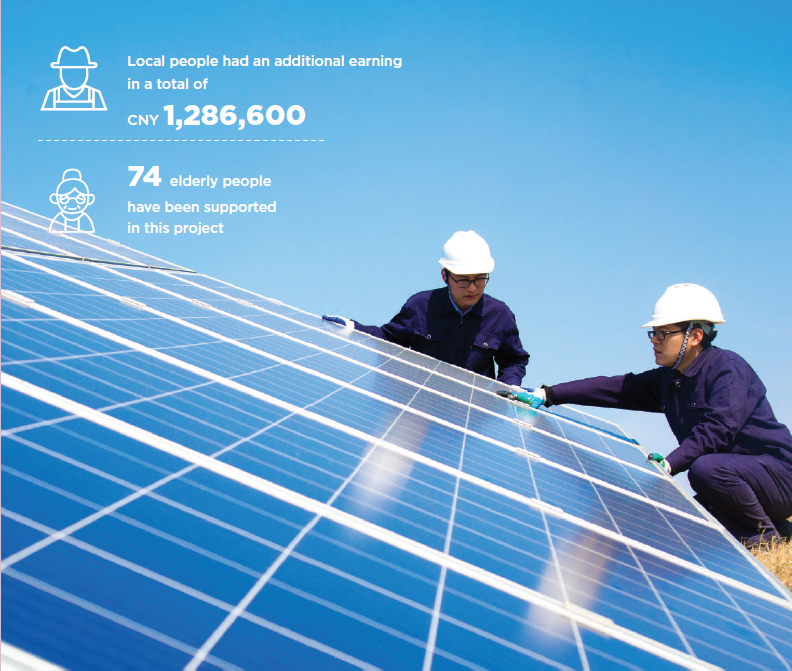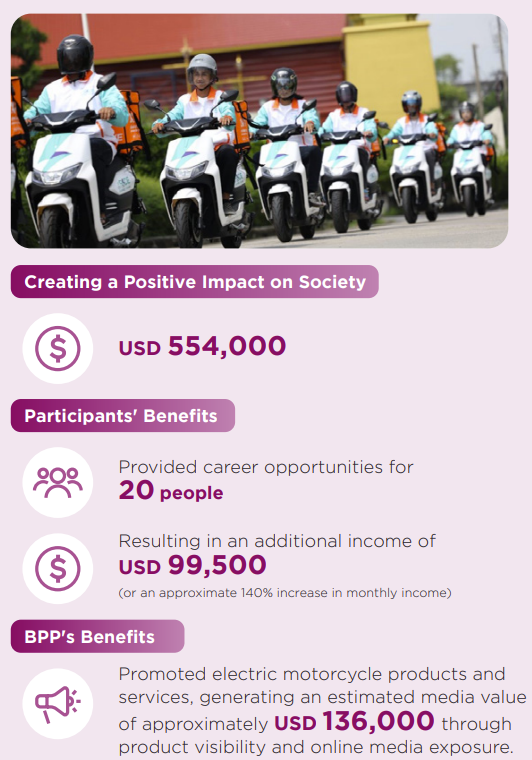Community Engagement
Significance
Communities surrounding the power plants are important stakeholders in BPP’s operations as they experience both positive and negative impacts throughout the project’s life cycle. As a result, community endorsement is a significant factor in the project’s sustainability.
BPP has given great importance on engaging with communities, including listening to community’s opinions since the project’s feasibility study commencement. This is to gather opinions and concerns from the communities to use them for creating the engineering designs and reducing any impacts likely arising. Additionally, the monitoring and preventive measures are established during the project’s construction and operational stages, while the opinions obtained from community engagement are used to improve BPP’s operations, driving towards the sustainable development corresponding to local needs.
Management Approach
BPP determines to conduct a social baseline study in the areas in accordance with the international standards during the project’s feasibility study stage. The aim is to understand economic and social contexts of the project’s area. It also sets up practice guidelines for engaging with communities and applying them as seen appropriated for each area.
BPP creates community engagement through stakeholder’s analysis procedures, dividing involved parties into directly and indirectly affected groups, as well as beneficiaries since a commencement of the feasibility study. The aim is to listen to community’s opinions and concerns, using such opinions and worry for designing projects as well as establishing proper measures to mitigate social and environmental impacts for each area. In general, the project’s stakeholders are classified based on the impact levels resulted from project operations. A distinguishment, however, may be different from local conditions and applicable laws of each country, for example:
- Communities located in the project area are those living in the project’s zones and necessarily being relocated. Members of these communities are the most affected people during the project’s commencement stage since relocation has an impact on the community’s traditional living, and possibly affects their occupations, cultures, and traditions, etc. Therefore, understanding and well planning for relocations as well as supporting such communities for their best benefits with minimal effects is a must. The unwilling relocation is avoidable, which is a challenge for the project achievement.
- Communities living proximity to the project are those residing adjacent to the project’s areas or 5 kms away (radius may vary upon each area). These communities are directly affected and are closest to the project. As a result, BPP has counted them as the most affected stakeholders during the operational stage. Subsequently, the communities residing in proximity to the project, together with those staying in the project’s areas will be provided with maximum opportunities, such as job recruitment, occupational support, etc.
- Communities living in the moderate vicinity of the project are those located over 5 kms from the project area but not exceeding 10 kms (radius may vary upon each area), or the communities BPP purchased lands for operating, but do not have to relocate. These communities are directly affected by the project, but less than the first two groups. As a result, this community group is considered as the moderately affected stakeholders.
- Indirectly affected communities are those residing far away from the project areas or the ones supporting the relocation, which may be indirectly affected, for instance, increasing the population and transportation densities. BPP considered this group of communities as the least important stakeholders, when compared to the first three groups.
BPP set up a unit with a direct responsibility on creating community engagement, conducting the public hearings and community opinion surveys so as to develop an operational plan appropriated for each locality, including a vulnerable group, such as persons unable to protect their rights or have no freedom to make decisions on effects they may receive, namely children, the elderly, migrants, and indigenous groups, etc.
Performance
- None of significant community complaints.
- None of the business halts resulted from community complaints.
Key Activities and Projects

The Vinh Chau Wind Power Plant project is considered as Banpu Power’s first step in conducting the power business in Vietnam that the surrounded community is an important stakeholder for its operation. The community living surrounding the project have been affected both positively and negatively throughout the project period.
The Company, therefore, places great attention to social data studies in the project areas. Moreover, a community engagement process and a community’s opinion hearing have been carried out prior to project construction. These include data gathering from the community engagement. All data collected is brought up and lead to the project design and decision making. Furthermore, all dimensions of possible impacts is monitored during both the project construction and operation.
In 2019, the Company conducted a study on social data with key activities such as:
- Gathering secondary social data and related laws
- Surveying and collecting of basic socio-economic data such as a number of populations per household, ethnicity, religion, local culture, education, occupations, unemployment, incomes and expenditures per household compared to the poverty line, infrastructure, public health, land use, including vulnerable groups in the area
- Arranging meetings for small community groups and stakeholders living surrounding the project and government officials to clarify project details, listening to their opinions, answering their questions and providing relevant information. There were 159 people selected via a sampling method with statistical principles participating in the meetings, divided into nine small-group meetings. A survey of 90 households was also organized.
- Drafting the grievance procedure and correction process
- Drafting a community engagement plan
The Company is able to use data from the locally social studies to create community engagement and look for opportunities to be a part in promoting the sustainable development in the future.

Haoyuan Solar Power Plant is located next to Ma Ziyu Village, Taian City, Shandong Province, China. This village is a rural village that faced with severe droughts during the winter season and has limited infrastructures, i.e. electricity and illuminations and water supply.The majority of Ma Ziyu population works in the agriculture field and most of the population is an elderly. 60% of them are 60-90 years old while 30% are 50-60 years old.
The Haoyuan Power Plant has implemented community engagement activities through surveying the needs of Ma Ziyu community members. The survey found that they need to improve the quality of life such as basic infrastructures, skills development and employment so as to increase their household incomes.
Consequently, Haoyuan Power Plant has implemented various community engagement and social responsibility activities focusing on improving the quality of life and occupational creation in addition to treating the Ma Ziyu community member.
The community engagement and social responsibility activities are as follows:
- Organizing the mechanic-skill trainings for maintenance works at the power plants for community members, such as solar panel maintenance, cable routing construction, and power plants cleaning
- Hiring contractors to work at the solar power plants such as construction, fence installation, solar panel maintenance, mowing, cable routing construction and road maintenance, etc.
- Installing solar street lights in the village roadways
- Home maintenance for the elderly, lifting their living conditions
- Organizing activities to build relationships with the elderly in the area, such as cooking food for the elderly during festive seasons, providing necessities for the elderly during the winter, and participating in cultural activities

The Company has placed great importance on respecting human rights and indigenous people engagement, although there is none of indigenous people staying in most of the company operation. The Company has to study and gain better understanding at the feasibility study stage so that the project can operate smoothly and will not affect ways of life and cultures of these native people. The Company has also put emphasis on cultural conservation, fair quality of life promotion such as public health and education, promotion of native products, and providing more job opportunities compared to people from other regions.
Located in Shaijiazhuang City, Zhengding County, Hebei Province, People’s Republic of China, Zhengding CHP Plant has a total installed capacity of 73 MW, generating about 10 million gigajoules of heat per year for users in Zhengding County, consisting of the industrial sector and communities in Zhengding City. It is the only power plant supplying heat into a centralized heating system, which is essential to people during the cold winter months. Recognizing its responsibility on the well-being of local communities, Zhengding CHP Plant has carried out the production process improvement projects in parallel with responding to the community needs, for example:
- Improving the air quality released from power plant’s stacks, with an investment of about CNY 200 million. The project has helped the power plant’s released air quality being significantly better than the standards required by laws. The plant can control pollution to an ultra-low emission level in both the amount of particular matters, sulfur dioxides and nitrogen oxides. As a result, Zhengding CHP Plant has been recognized by the government and has been selected as one of then Top 100 Eco- environmental Innovation Projects in 2020.
- Enhancing and expanding the production capacity in order to accommodate people in the area to be allocated heat from a centralized heating system thoroughly, responding to urbanization and population expansion. Currently, the plant has covered about 96% of the services.
- Extending the period of heat supply to the community during the winter season for several consecutive years in response to community needs.
- Increasing convenience for users by improving the payment system to be in the digital format.
- Providing 24-hour hotline service to solve problems that may arise with customers and communities, especially hospitals, schools, etc.
- In 2021, The plant collaborated with the government sector to improve heat exchange station for providing efficient service to the community, by improving the heat supply system, such as installing signal receivers, maintaining and building a remote monitoring system to increase the stability and efficiency of the heat supply system, which can operate continuously and efficiently.
Such operations have yielded fruitful contributions to a community of approximately 58,000 residents who continuously use heat with high quality and cost-effectiveness during the winter. This has caused people in the area to switch to a centralized heating system from the traditional heating method. As a result, the number of customers of Zhengding CHP Plant has continued to increase. In 2021, the community heat sales volume exceeded the target by 35.2%, with community heat sales revenue of CNY 27.3 million. Meanwhile connection fee income was recorded at CNY 12.2 million and CNY 24.3 million of a governmental subsidy (tariff).

Due to its efficient operations with environmentally-friendly manner, Zhengding CHP Plant has been trusted by the government and community. More importantly, the plant has been selected by the government to develop a solar rooftop project in Zhengding City, with an aim to install a total of 167 MW of solar panels on the roofs of governmental buildings, factories and communities, expected to be completed by the year 2023.
The solar power plants in China have continually implemented the projects for improving the quality of life and improving the economy according to the needs of each locality, especially that in rural areas where quality of life is still required for better improvement. The goal of this project is to upgrade the quality of life and promote occupation creation in the communities, including building an understanding between the power plant and the communities. A number of professional skills development projects have been undertaken in order to generate income from co-working with the power plants, such as cleaning solar panels to increase power generation efficiency, weeding and cleanliness to prevent fire, cable routing, construction and cleaning, etc.
In addition, safety and environmental training has been provided in tandem with supporting safe operation in the workplace. The participants of this project are residents from surrounding communities, most of whom are working in the agriculture field. The project has resulted in an additional earning in a total of CNY 1,286,600 for local people. Moreover, it has created engagement and good relationships with the community as well as yielded benefits to the company in maintaining the power plant to be able to generate electricity with the highest efficiency.

Throughout the past year, the company’s solar power plants in China have been able to generate power continuously without any interruption. In addition, the surrounding communities have also helped monitor security around the projects in another way. Besides, other quality of life improvement projects have been also implemented, such as:
- Having been supporting the improvement of the quality of life of the elderly, who are the major population in the areas surrounding the power plants since 2017. In 2021, 74 elderly people have been supported in this project.
- The installation of solar lighting in the village roads for safety.
- Home maintenance for the elderly so that they have a better life.
- Conduction of the cultural activities to build relationships with the communities, such as cooking food for a traditional festival, providing support for living during winter, giving hands to local communities during the COVID-19 pandemic.
Banpu NEXT has implemented the “Light & Learn” social responsibility project by bringing solar power system to electricity-deprived schools in remote areas to help light up learning opportunity and benefit the children.
In the previous year, the employees joined forces with highland teaching volunteers, arranged nature and solar energy learning activities for children of Ban Po Por Kee in Tak province, a community learning center located in a backcountry area. The kids who come to class at this learning center are from a Thai highlander community. They normally use their own dialect and cannot speak Thai, making difficulty both in general communication and education. Banpu NEXT, therefore, installed solar power system and storage batteries, including provision of TV sets and learning media, with an aim to help manage learning through quality media, enabling children to practice speaking Thai with faster results. In addition, community members can come to the center and use these devices, believed to give them a better quality of life.
Moreover, the working group also organized recreational activities, and fostered imagination through arts, including learning the value of nature and clean energy, such as a natural tie-dry fabric and paper mask making workshop letting them use natural materials to make a mask in their individual styles. Other activities organized include home-grown vegetable planting, educational solar power storytelling, charity lunch, and gift giveaway to the children.
Over the past 5 years, Banpu NEXT has promoted employees’ participation in volunteer activities. It has established collaborative network from external agencies in local areas to bring solar power system to create changes and help light up learning opportunity and benefit to children in remote and electricity-deprived areas. The solar power system has already been introduced to 73 electricity-deprived schools in remote areas, with more than 73,000 watts of installed capacity all combined, which benefit over 2,400 children altogether. Moreover, satellite dishes and TV sets to enable their access to distance learning media plus many other learning materials and necessities were also provided.
Banpu NEXT is a joint-venture company BPP has invested with 50% of stakes in order to create growth in renewable energy and energy technology businesses

HPC Power Plant is located in a rural area of Xayaburi Province, Lao PDR, with a local population of approximately 27,000 people. Prior to commencing the project, the community had health concerns, especially in the area of environmental quality resulted from a construction of the power plant. Meanwhile, community members also needed to improve their health and basic public health in the area. HPC Power Plant, therefore, has joined hands with the government and communities to systematically develop a health surveillance system and promote the household and community health since it began operating in late 2012.
HPC Power Plant in collaboration with Public Health Department has established the community volunteers and provided training courses to promote understanding of household health, environmental health and basic public health. The household environmental health indicators have been created for volunteers to use during the monthly monitoring, such as behaviors regarding storing and using water for consumption, food preparation, waste management, cleanliness, household illnesses, etc. The household environmental health conditions are, then, classified into three levels, including a good level, a moderate level and a level needs to be improved. The volunteers will be the ones who give suggestions for improvement, such as cooking food to perfection, elimination of insects, which are disease carriers, wastewater management, hygienic management of pet corrals, etc. In addition, the health and environmental surveillance system is also a way to receive suggestions or concerns from the community to improve and communicate information on HPC’s environmental quality measurements to local communities on a regular basis.
HPC Power Plant has created a health surveillance database converted into the “Geographic Information System” to enable spatial management, able to link environmental quality measurement results with the community’s health status from the beginning of the project up to now. The system can also link the database to other management activities, such as career promotion activities efficiently.
Banpu NEXT, in collaboration with Lalamove – a business partner providing an on-demand delivery application, has officially inaugurated the Ride for Chance, Ride for Change Project. The project is aimed at empowering people with disabilities by providing them with the parcel delivery job. A total of 20 disabled people are participating in the project, divided into 16 people with hearing impairments, and 4 people with mobility disabilities.
The Ride for Chance, Ride for Change Project focuses on empowering disabled individuals and supporting them in starting a career as parcel delivery riders. The project lasts 12 months, which participants will receive an electric motorcycle with comprehensive insurance for working as a parcel transporter. They will be exempted from member registration fees and will be trained in all necessary skills, including safe driving, customer services and the use of technology. In addition, a specific system was designed to facilitate the project participants to build confidence and help them overcome obstacles in their work.

Document Download
Community Development Policy

Stakeholder Engagement Standard












